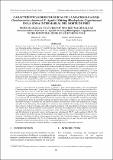Por favor, use este identificador para citar o enlazar este ítem:
https://hdl.handle.net/20.500.12958/3495Registro completo de metadatos
| Campo DC | Valor | Lengua/Idioma |
|---|---|---|
| dc.contributor.author | Uribe Alzamora, Roberto | - |
| dc.contributor.author | Atoche Suclupe, Dennis | - |
| dc.contributor.author | Paredes Paredes, Jacinto | - |
| dc.contributor.author | Seclén Leyva, Josep | - |
| dc.date.accessioned | 2021-01-08T03:39:52Z | - |
| dc.date.available | 2021-01-08T03:39:52Z | - |
| dc.date.issued | 2020 | - |
| dc.identifier.citation | Bol Inst Mar Perú. 35(2) 2020, p. 271-293 | es_ES |
| dc.identifier.issn | 04587766 | - |
| dc.identifier.uri | https://hdl.handle.net/20.500.12958/3495 | - |
| dc.description.abstract | En La Libertad en invierno y primavera 2018 se estudió a la macroalga roja Chondracanthus chamissoi “yuyo” o “mococho”. En Trujillo, Paiján y Pacasmayo se determinaron 21 praderas; se realizaron transectos perpendiculares a la línea de costa y tres cuadratas (0,25 m2 c/u) en cada transecto; de cada cuadrata se extrajeron los organismos. Las muestras de macroalgas fueron separadas para su análisis, y las de flora y fauna acompañante fueron registradas in situ como presente/ ausente. Se describió tipo de sustrato y características físico-químicas del agua (temperatura, oxígeno y pH). En laboratorio las muestras de C. chamissoi fueron lavadas con agua corriente, se determinó tallas, densidad (ind./m2), biomasa y se diferenciaron ejemplares con estructuras reproductivas (cistocarpos). Los resultados muestran que la mayoría de praderas se encuentran en orilla de arena y fondo de piedras. Los estadísticos de tendencia central y de dispersión calculados fueron similares. Las densidades en promedio fueron de 322 plantas/m2 en invierno y 292 plantas/m2 en primavera. La biomasa en invierno se estimó en 277,77 t y en primavera 650,69 t. El grupo taxonómico con mayor frecuencia fue Rhodophyta (algas rojas) y las especies más representativas C. chamissoi, Asterfilopsis furcellata (=Gymnogongrus furcellata) y Grateloupia doryphora. La biomasa de otras macroalgas se estimó en 11,17 t para Chondracanthus glomeratus “clavo” o “yuyo clavo” en invierno y 3,53 t en primavera, para Gracilariopsis lemaneiformis “pelillo” se estimó en 1,77 t. | es_ES |
| dc.description.abstract | ABSTRACT: In winter and spring 2018, we studied the red macroalgae Chondracanthus chamissoi known as yuyo or mococho in La Libertad Region. In Trujillo, Paiján, and Pacasmayo, we determined 21 meadows by performing transects perpendicular to the coastline and three quadrats (0.25 m2 each) in every transect. We extracted the organisms from each quadrat, then we separated the samples of macroalgae for analysis from those of accompanying flora and fauna which were recorded in situ as present/absent. We described the type of substrate and the physical-chemical characteristics of the water (temperature, oxygen, and pH). In the laboratory, the samples of C. chamissoi were washed with running water. We determined sizes, density (ind./m2), biomass, and differentiated specimens with reproductive structures (cystocarps). The results show that the majority of the meadows are found on sandbanks and stone bottoms. The central tendency and dispersion statistics calculated were similar. The mean densities were 322 plants/m2 in winter and 292 plants/m2 in spring. In winter, the biomass was estimated at 277.77 t and in spring at 650.69 t. The most frequent taxonomic group was Rhodophyta (red algae) and the most representative species were C. chamissoi, Asterfilopsis furcellata (=Gymnogongrus furcellata), and Grateloupia doryphora. The biomass of other macroalgae was estimated at 11.17 t for Chondracanthus glomeratus clavo or yuyo clavo in winter and 3.53 t in spring, for Gracilariopsis lemaneiformis pelillo it was estimated at 1.77 t. | - |
| dc.language.iso | spa | es_ES |
| dc.language.iso | eng | - |
| dc.publisher | Instituto del Mar del Perú | es_ES |
| dc.relation.ispartofseries | Boletín Imarpe;35(2), 2020 | - |
| dc.rights | info:eu-repo/semantics/openAccess | es_ES |
| dc.rights.uri | https://creativecommons.org/licenses/by/4.0/ | es_ES |
| dc.source | Instituto del Mar del Perú - IMARPE | es_ES |
| dc.source.uri | Repositorio Digital IMARPE | es_ES |
| dc.subject | Macroalga roja | es_ES |
| dc.subject | Biomasa | es_ES |
| dc.subject | Chondracanthus chamissoi | es_ES |
| dc.subject | La Libertad | es_ES |
| dc.title | Características bioecológicas de la macroalga roja Chondracanthus chamissoi (C. Agardh) Kützing (Rhodophyta, Gigartinaceae) en la zona intermareal del norte del Perú | es_ES |
| dc.title.alternative | Bioecological features of the red macroalgae Chondracanthus chamissoi (C. Agardh) Kützing (Rhodophyta, Gigartinaceae) in the intertidal zone of northern Peru | es_ES |
| dc.type | info:eu-repo/semantics/article | es_ES |
| Aparece en las colecciones: | Boletín 35(2), 2020 | |
Ficheros en este ítem:
| Fichero | Descripción | Tamaño | Formato | |
|---|---|---|---|---|
| Bol 35(2)-6.pdf | 10,84 MB | Adobe PDF |  Visualizar/Abrir |
Este ítem está sujeto a una licencia Creative Commons Licencia Creative Commons

